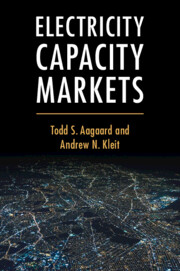Book contents
- Electricity Capacity Markets
- Electricity Capacity Markets
- Copyright page
- Contents
- Figures
- 1 Introduction
- 2 Capacity Markets Primer
- 3 Restructured Electricity Markets and Regional Transmission Organizations
- 4 Reliability and the Missing Money Problem
- 5 Capacity Policies
- 6 First-Generation Capacity Markets
- 7 Second-Generation Capacity Markets
- 8 Capacity Market Demand
- 9 Capacity Market Supply
- 10 Capacity Market Design
- 11 Market Power
- 12 Minimum Offer Price Rules
- 13 The Texas Alternative
- 14 Conclusion
- Index
- References
3 - Restructured Electricity Markets and Regional Transmission Organizations
Published online by Cambridge University Press: 24 February 2022
- Electricity Capacity Markets
- Electricity Capacity Markets
- Copyright page
- Contents
- Figures
- 1 Introduction
- 2 Capacity Markets Primer
- 3 Restructured Electricity Markets and Regional Transmission Organizations
- 4 Reliability and the Missing Money Problem
- 5 Capacity Policies
- 6 First-Generation Capacity Markets
- 7 Second-Generation Capacity Markets
- 8 Capacity Market Demand
- 9 Capacity Market Supply
- 10 Capacity Market Design
- 11 Market Power
- 12 Minimum Offer Price Rules
- 13 The Texas Alternative
- 14 Conclusion
- Index
- References
Summary
In the 1990s, many electricity markets in the United States moved away from traditional public utility regulation and toward competitive markets. Regional transmission organizations (RTOs), under the oversight of the Federal Energy Regulatory Commission (FERC), operate the electricity grid in areas with competitive markets. These markets include energy markets that sell power, ancillary services markets that sell services necessary to maintain the stability and security of the grid, and capacity markets.
- Type
- Chapter
- Information
- Electricity Capacity Markets , pp. 23 - 36Publisher: Cambridge University PressPrint publication year: 2022

